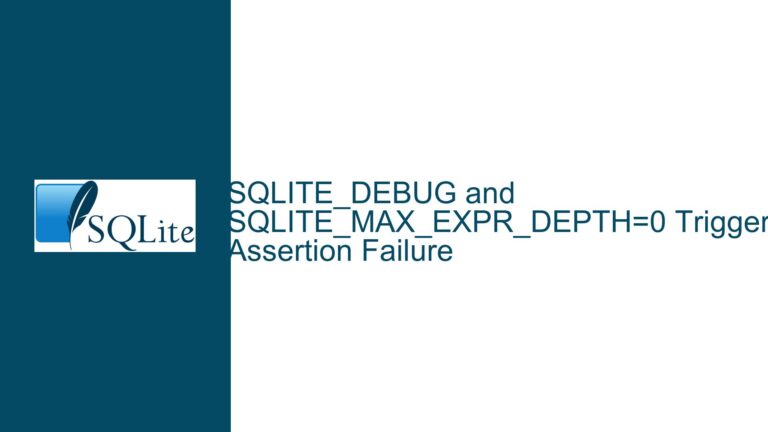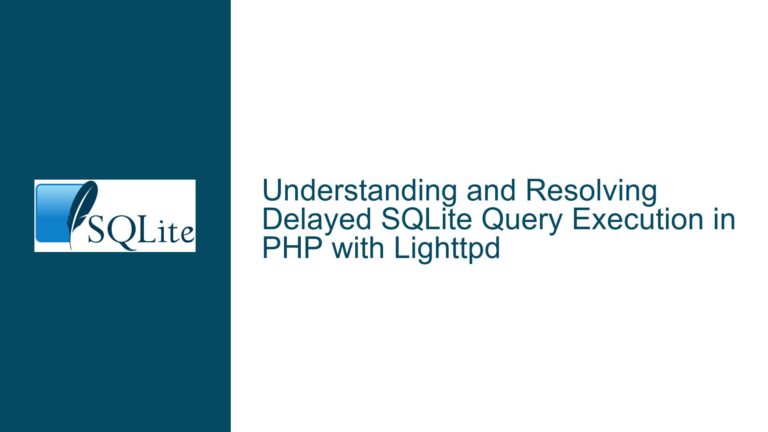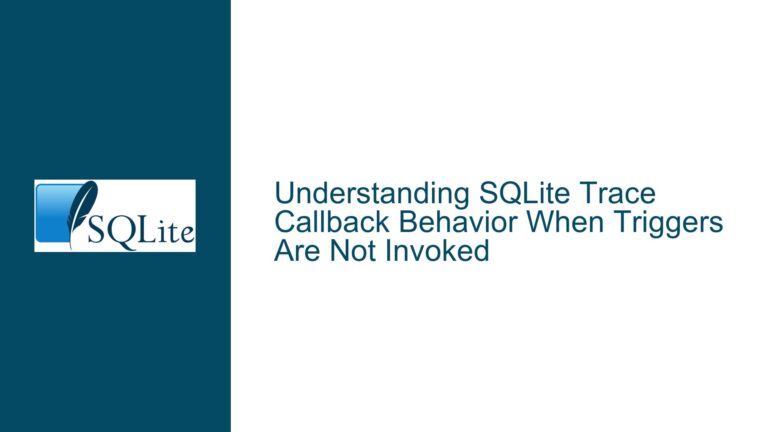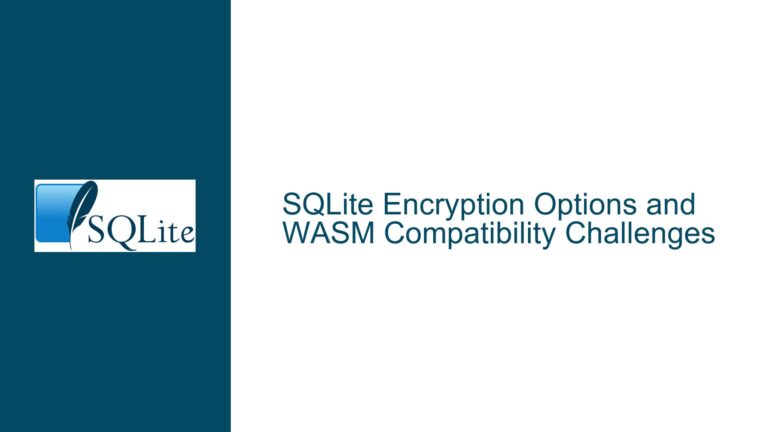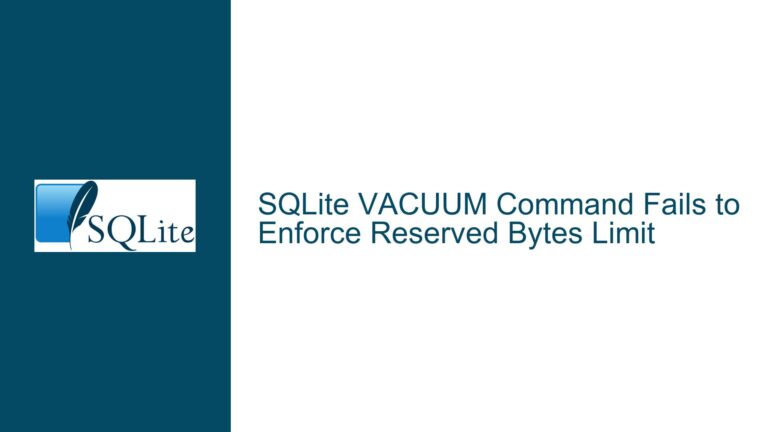Ensuring Atomicity in SQLite Backup: Destination State After Aborted Operations
Understanding the Transactional Guarantees of SQLite Backup Operations
The SQLite backup API (sqlite3_backup_init(), sqlite3_backup_step(), and sqlite3_backup_finish()) is designed to create a byte-for-byte copy of a source database into a destination database. A critical aspect of this process is its transactional atomicity: either the entire backup completes successfully, leaving the destination database in a state identical to the source, or the backup is aborted, leaving the destination database in its original state. This guarantee hinges on how SQLite manages transactions during the backup process.
When a backup is initiated, SQLite opens a write transaction on the destination database. This transaction remains active until the backup completes (i.e., sqlite3_backup_step() returns SQLITE_DONE) or is explicitly terminated via sqlite3_backup_finish(). If the backup is abandoned prematurely—for example, due to an application error, intentional cancellation, or an interrupted process—the write transaction is rolled back. This rollback ensures that any partial changes made to the destination database during the backup are discarded, preserving its original schema and data.
Key scenarios to consider include:
- Overwriting Existing Tables: If the destination database contains a table named "items" with specific data or schema, and the backup process copies a different "items" table from the source, the destination’s original "items" table will remain intact if the backup is aborted.
- Schema Conflicts: If the source and destination databases have tables with the same name but different schemas (e.g., differing column definitions or constraints), the destination’s schema will not be altered unless the backup completes fully.
- Missing or Extra Tables: If the source database contains tables absent in the destination (or vice versa), these tables will only appear in or disappear from the destination if the backup finishes successfully.
The atomicity of the backup process is rooted in SQLite’s transactional model, where all changes—including Data Definition Language (DDL) operations like CREATE TABLE, ALTER TABLE, or DROP INDEX—are treated as part of a single transaction. Unlike some RDBMS (e.g., MySQL, Oracle), SQLite allows DDL operations to occur within explicit transactions, ensuring that schema modifications are atomic and reversible if the transaction is rolled back.
Mechanisms Behind Partial Backup Failures and Schema Consistency
The integrity of the destination database during an aborted backup stems from three foundational mechanisms in SQLite:
Write Transaction Isolation:
The backup API holds an exclusive write transaction on the destination database for the duration of the backup. This transaction isolates the backup process from other concurrent operations, ensuring that no external changes interfere with the destination’s state until the backup is finalized. If the backup is abandoned, SQLite rolls back this transaction, undoing any partial page copies or schema modifications.DDL Within Transactions:
In SQLite, schema changes (DDL) are not auto-committed. They are part of the ongoing transaction and subject to rollback. For example, if a backup process begins copying aCREATE TABLEstatement but is interrupted, the destination database will not retain a partially created table. This contrasts sharply with systems like Oracle, where DDL statements implicitly commit active transactions, making atomic rollbacks impossible.Page-Level Copying:
The backup API operates at the page level, copying database pages from the source to the destination. This approach avoids parsing SQL statements or reconstructing schemas, ensuring that the destination’s physical storage matches the source’s. However, this also means that partial page copies (from an interrupted backup) are discarded during rollback, as they are part of the uncommitted transaction.
A critical edge case arises when the source and destination databases have conflicting schemas. Suppose the source has a table items with columns (id, name), while the destination’s items table has (id, description). During a backup, SQLite does not attempt to merge or reconcile these schemas; instead, it overwrites the destination’s schema with the source’s. However, if the backup is aborted, the destination’s original schema remains untouched because the transaction rolling back undoes the overwrite.
Resolving Backup Integrity: Verification, Handling, and Best Practices
To ensure the destination database remains consistent during and after a backup operation, follow these steps:
1. Validate Transaction Boundaries:
Confirm that the backup process uses a single write transaction on the destination. This can be verified by monitoring the destination’s transaction journal (if in rollback journal mode) or write-ahead log (WAL mode). If the backup is aborted, check that the journal or WAL file is deleted or truncated, indicating a successful rollback.
2. Handle Backup Interruptions Gracefully:
Always call sqlite3_backup_finish() regardless of whether the backup completes. This function ensures that the write transaction is properly closed or rolled back. For example:
sqlite3_backup *pBackup = sqlite3_backup_init(dest_db, "main", source_db, "main");
if (pBackup) {
int rc;
do {
rc = sqlite3_backup_step(pBackup, 5); // Copy 5 pages per step
if (rc == SQLITE_BUSY || rc == SQLITE_LOCKED) {
sqlite3_sleep(250); // Retry after a delay
}
} while (rc == SQLITE_OK || rc == SQLITE_BUSY || rc == SQLITE_LOCKED);
sqlite3_backup_finish(pBackup); // Critical for cleanup
}
3. Test Schema and Data Conflicts:
Simulate scenarios where the source and destination have conflicting tables or schemas. For instance:
- Create a destination table
itemswith a columnprice INT. - Initiate a backup from a source where
itemshasprice REAL. - Abort the backup before completion.
- Verify that the destination’s
itemstable retains its originalINTtype forprice.
4. Monitor Backup Progress:
Use sqlite3_backup_remaining() and sqlite3_backup_pagecount() to track the backup’s progress. If the remaining pages do not decrease over time, investigate locks or contention on the source database.
5. Enable Error Logging:
Log all return codes from sqlite3_backup_step() and sqlite3_backup_finish(). Common error codes include SQLITE_LOCKED (source database is busy) and SQLITE_READONLY (destination is not writable).
6. Prefer WAL Mode for Concurrent Backups:
If the source database uses WAL mode, backups can proceed without blocking reads or writes. However, ensure that the destination database is in a compatible mode to avoid file format mismatches.
By adhering to these practices, developers can ensure that SQLite backups are atomic, reliable, and free from partial state corruption. The destination database will either reflect the source’s exact state at the start of the backup or remain entirely unchanged—a guarantee rooted in SQLite’s transactional design.

